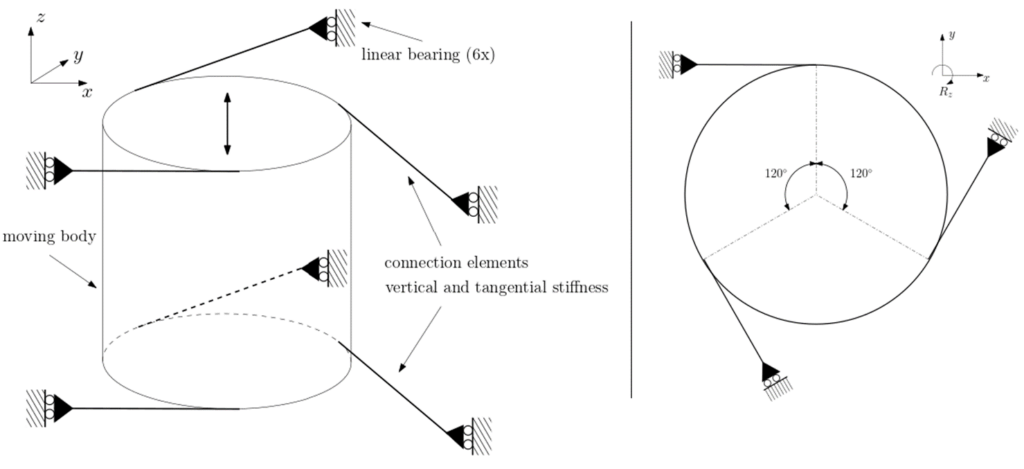Chapter 2 - Design using flexures
Chapter 3 - Design for static stiffness
Statically determined long stroke linear guide
Introduction
Creating a statically determined high stiffness linear guiding over a long stroke, with high resonance frequencies, free of backlash or play, and with an axisymmetric thermal center is not trivial. To ensure a sufficiently long service life without posing stringent manufacturing tolerances on the make parts, a statically determined design is desired avoiding uncontrollable high reaction forces. Therefore the concept requires exactly five constraints to allow translation in one direction. The guiding must provide high stiffness in the constrained degrees of freedom to achieve resonance frequencies above 300 Hz. Long term stability is of importance, therefore an axisymmetric system with a thermal center is desired.
Principle
By combining multiple bearings, and distributing them at relatively large distances, the resulting stiffness obtained is significantly higher than the stiffness of an individual bearing, in particular for the rotational stiffnesses.
Concept
In this example a total of six commercially available rolling element bearings are divided into two sets of three, an upper set and a lower set. Each set contains three bearings separated by 120 degrees where the bearings are oriented tangentially to the moving object, see Figure 1.

Figure 1. Concept of linear guide with two sets of six tangentially distributed bearings

Figure 2. Concept with torsional compliant body
Each bearing is connected to the moving body through an A-frame that provides high stiffness in tangential direction (to constrain the moving body), and in vertical direction (to connect to the carriage), shown in Figure 2. The upper set and lower set both constrain the Rz direction. A total of five linear bearings would be sufficient to create a linear guide, though adding the sixth bearing creates axisymmetry and a thermal center. To avoid overconstraining, the moving body is made torsionally compliant allowing the upper set of bearings to rotate with respect to the lower set of bearings. Otherwise the overconstraint in Rz direction would pose stringent requirements on the alignment of the bearings and on manufacturing tolerances of the individual parts. Then small alignment errors would cause large reaction forces, thereby impacting the service life of the bearings.
Benefits of the six times constrained design in combination with the torsion compliance:
- All linear bearings are preloaded by the stiffness of the torsional compliant body, eliminating any backlash or play in the bearings in static conditions
- Axisymmetric design with a thermal center
Developed by
- Rick Baade (VDL ETG)